
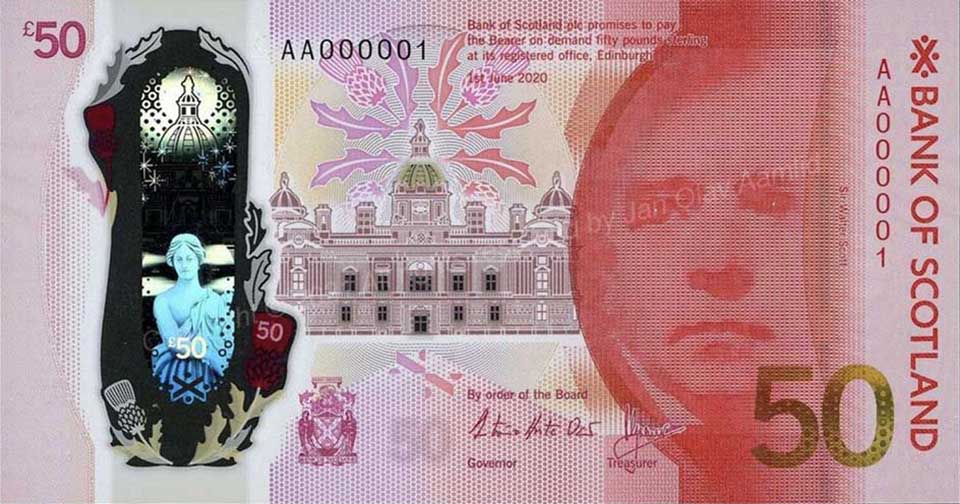
A charity auction was conducted by Spink London on behalf of the Bank of Scotland on June 30 2021. In this special action there were 96 lots of the new Scottish £50 polymer notes featuring the portrait of Scottish novelist and poet Sir Walter Scott alongside the image of The Mound in Edinburg. All the banknotes in the sale have solid and lucky numbers.
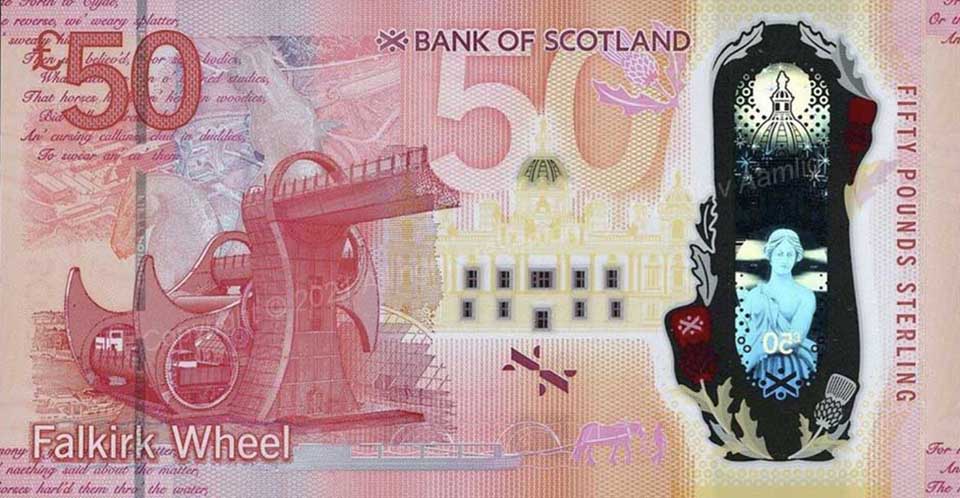
On the reverse is the Falkirk Wheel to reflect Scottish industry and culture. For the first time the Kelpies appear on the note, which represents the high significance of horses to the Scottish industry and economy. The poem featured on the note is “Steam Barge” by William Muir. The UV featured on the note depicts a horse pulling a channel barge.

The first note on sale was the £50 note with the number 000001. All the notes in the sale had the prefix AA. It was estimated to sell for GBP 4,000-6,000. The ultimate hammer price was GBP 21,000, including a 20% buyer premium amounts to app. THB 1,134,000.
The next note to be sold had the number 000002. This was estimated to sell for GBP 500-700, but the buyer ended up paying GBP17,000,app.THB897,000including buyer’s premium.
AA 000003 was also estimated at GBP500-700andsoldforGBP6,500,app. THB 351,000 including buyer’s fee. The notes with numbers from 000004 up to 000013 were estimated to sell from GBP 400-1,500 and sold from GBP 2,300-8,000, including buyer’s premium, app. THB 124,200 – THB 432,000.
Number 9 is very popular in Thailand and number 8 is the popular number for the Chinese so, number 000009 fetched THB 432,000 and number 000008 even had a higherestimation.Eventhoughallthenotes have the same rarity, number 000001 always sells for the highest amount. Many of us collectorswanttobethefirsttoownthefirst.
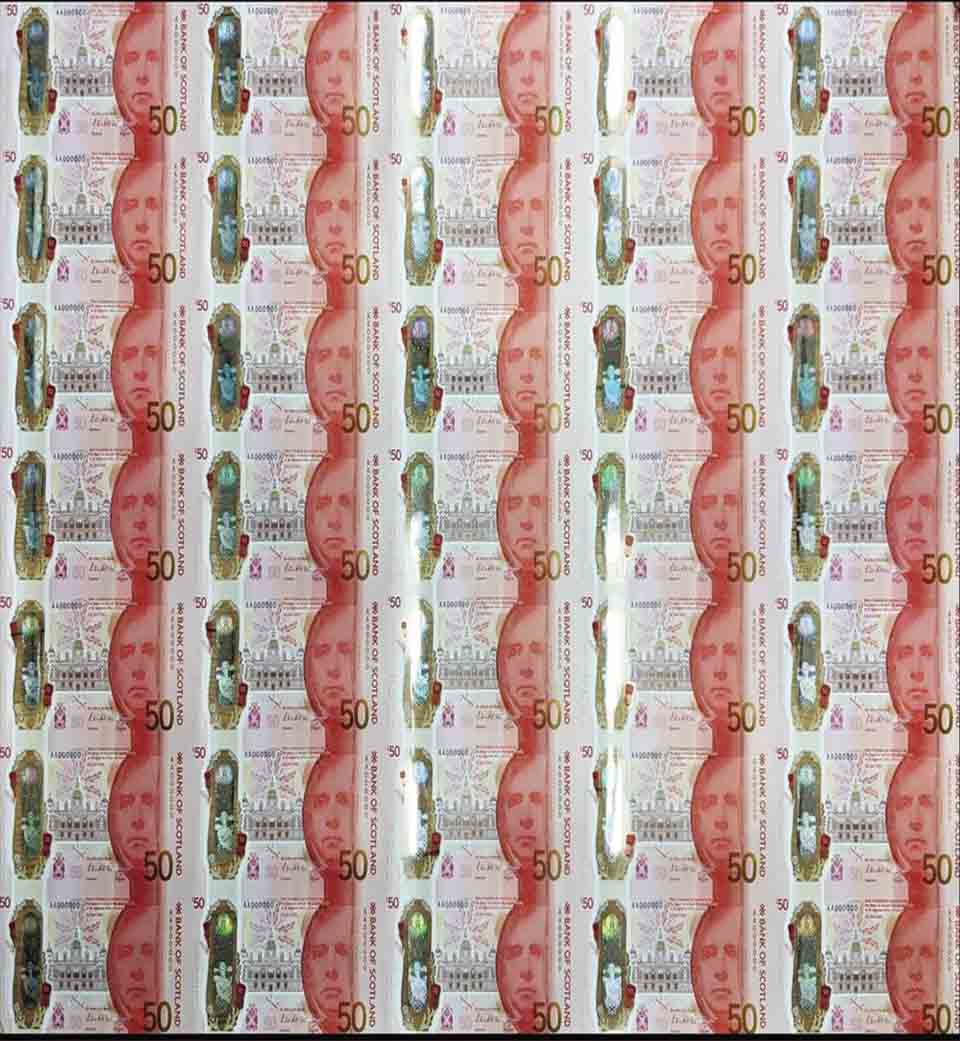
Two uncut sheets consisting of 35 pieces of the £50 banknotes were sold at the auction. Both were estimated at GBP 4,000-6,000. One sold for GBP 9,000, the other for GBP 9,500. That is app. THB 513,000 including buyers fee.
The last two lots were two £50 banknotes. Here the successful bidder could choose the number. They were both estimated to sell for GBP 2,500-3,500. Many bidders wanted to have a note where they could choose their favourite number, one sold for GBP 15,000, the other for GBP 13,000, which is app. THB 702,000 including buyer’s premium.
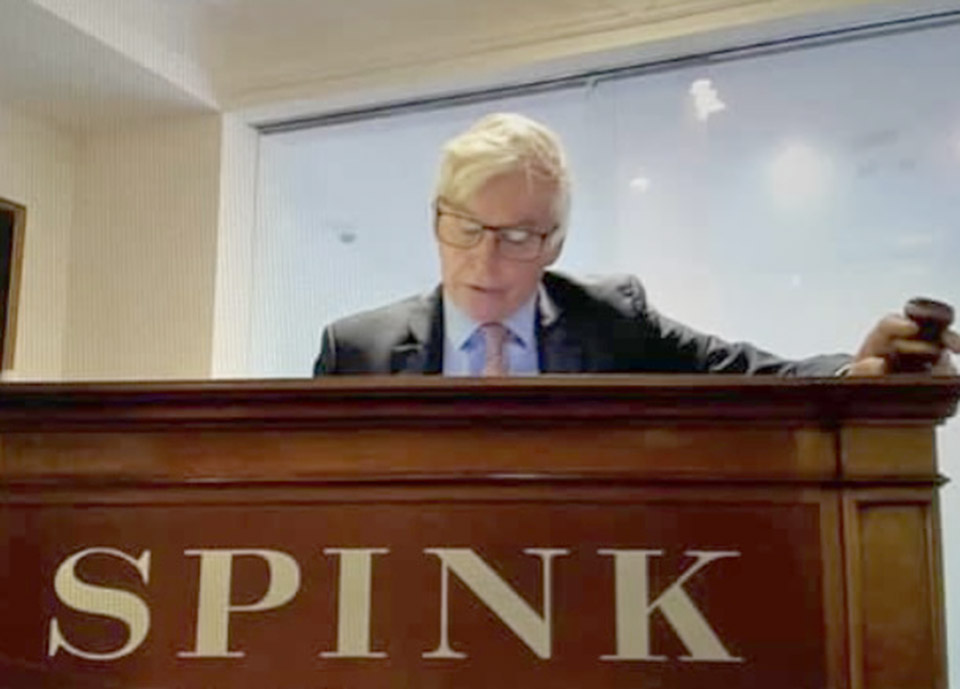
Spink have previously conducted numerous sales on behalf of the Bank of Scotland. Proceeds from the auction were donated to Mental Health UK. This year the total hammer price for the 96 lots was GBP 250,000, including the premium, app. THB 13,500,000 according to Barnaby Faull, a world-leading expert in banknotes.
Barnaby Faull has been working for Spink for 50 years, starting off with ancient coins, in the bullion department for some years, and most of the time as the Head of the Banknote department. Barnaby Faull was the auctioneer for this wonderful sale.

Spink, in partnership with the Bank of England, held another charity auction of the new polymer £50 featuring Alan Turner on July 15. The staff of the Bank of England has chosen three charities to benefit from the proceeds of the auction, The Albert Kennedy Trust, Childline, and Shelter.
The first lot has the serial number AA01 000011 and is estimated to sell for GBP 2,000-3,000 with a starting price of GBP 1,400. At the time of printing there was already a bid for GBP 4,500.
In my opinion the numbers of the notes in the Bank of England sale are not as interesting as the ones in the Bank of Scotland sale. Anyway, I am sure it will be a great success, as there are many keen collectors of banknotes issued by Bank of England, plus the funds will benefit three worthwhile charities. Another reason why this auction will be a success is that the banknote has the portrait of the popular Queen Elisabeth II. There are many notaphilists who avidly collect banknotes with the portrait of Queen Elisabeth II. The Queen is currently the world’s longest reigning monarch having sat on the throne for 69 years.
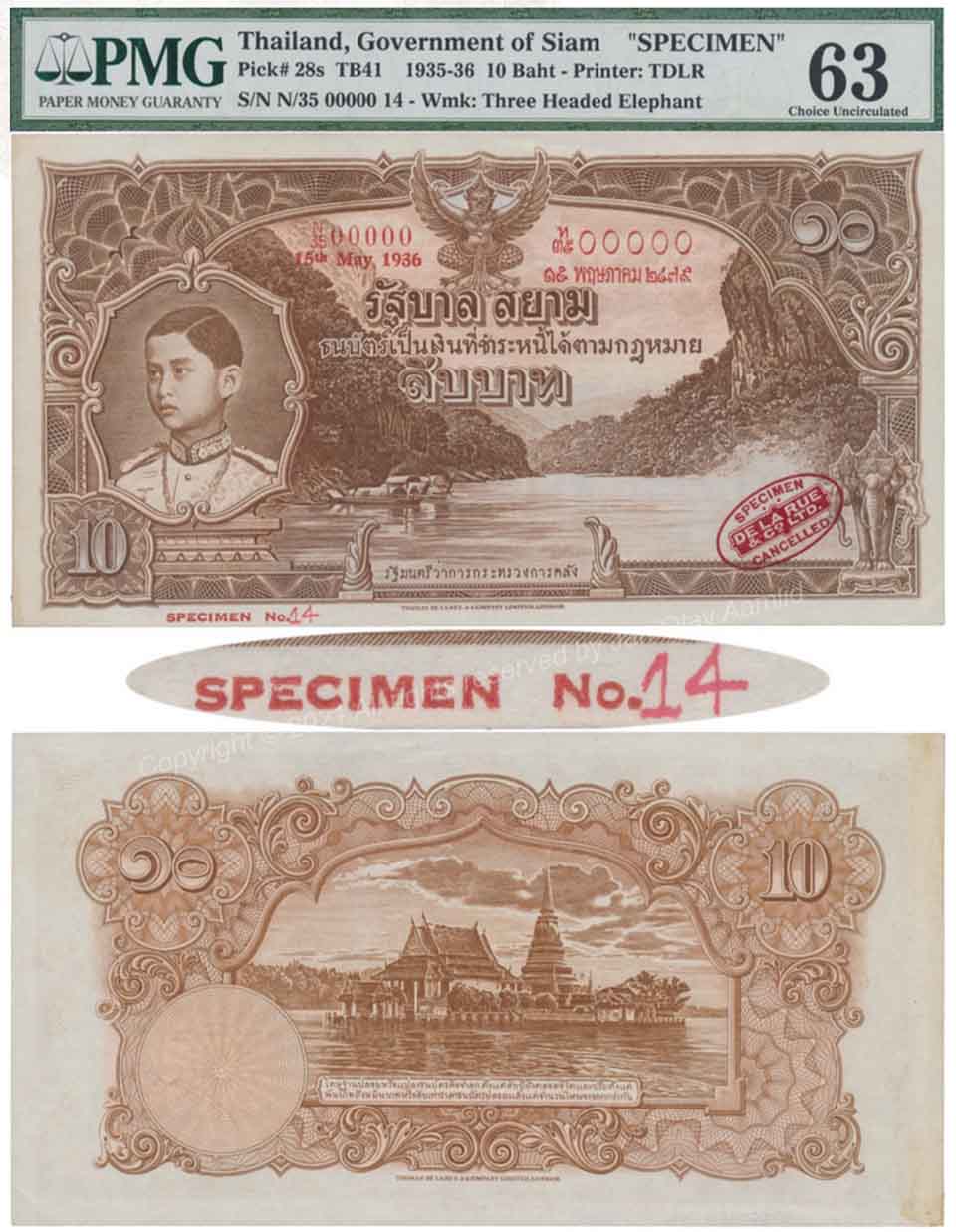
There is a great interest for specimen banknotes world-wide. Naturally the older the specimen banknotes the rarer they are. In the Eur-Seree auction #59 there are three specimen banknotes Third Series, Type II. They all have the portrait of King Ananda, Rama VIII. A 10 Baht note with serial number N50 00000 in AU, Almost Uncirculated; received a minimum price of THB 125,000. A 20 Baht note, also Third Series, Type II, serial number P20 00000, also graded AU, has a minimum price of THB 115,000.
The specimen note Third Series, Type II with the highest minimum price is a 10 Baht note dated 15th May 1936 at THB 160,000. It is graded by PMG, Paper Money Guaranty, to be 63, Choice Uncirculated. It has the oval, red “SPECIMEN DE LA RUE & Co Ltd. CANCELLED” stamp in the lower right corner. It has the serial number N35 00000 and is stamped “SPECIMEN no. 14” in the lower left margin. There are many collectors who collect notes with the oval TdlR SPECIMEN stamp. The stamp colour can be in red or in black.

Eur-Seree Collecting will be conducting their auction #59 on Saturday-Sunday August 7-8, 2021. In the sale there is a solid 1 Baht banknote Fourth Series, Type III, Japanese printing, announced on February 24, 1944. The serial number is D4 44444. The starting price is THB 120,000 but in my opinion it will sell for quite a bit more.

The interest for Banknotes with solid and lucky numbers has increased these last years. Fourteen years ago in the Eur-Seree auction #14 a 10 Baht with the serial number W88 888888, was unsold for Baht 40,000. The banknote was produced by Thomas de Rue & Company Limited London (TdlR). This time the very same banknote is offered with the same minimum price as 14 years ago, Baht 40,000, but I think the buyer will probably have to pay several times as much because of the large number of interested collectors.
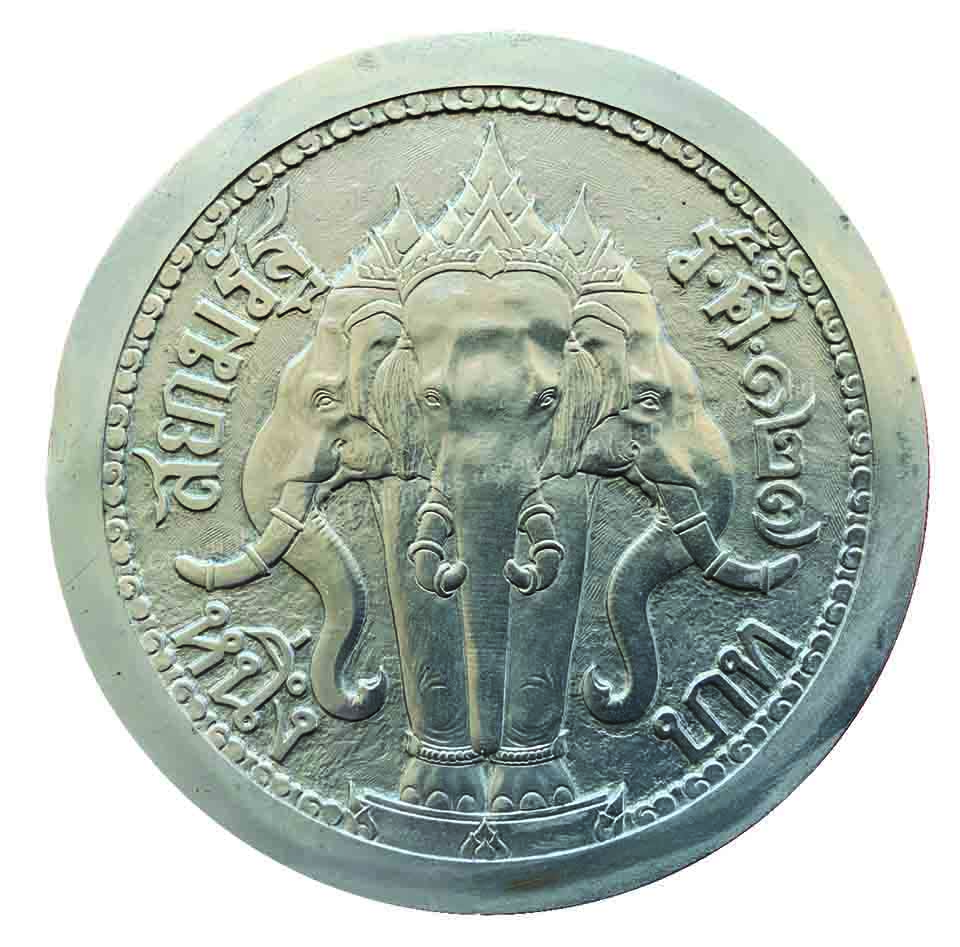

In the coin section there is a 130 mm one-sided working dies plaque from the Monaie de Paris. In my opinion it was used in the reduction machine to produce the dies for the popular One Baht RS127 (1908). The coins did not arrive in Thailand before King Chulalongkorn, Rama V, passed away and they were distributed at the Kings cremation.

In the medal section there are two very unusual medals from 1906, one in copper and one in silver. They were presentation medals for the “Weapons Contest – Wat Benjamabopit” in 1906. The obverse depicts the 1897 “Return from Europe” medal with the portrait of King Chulalongkorn, Rama V. On the reverse, the die was produced with blank space for engravings. The copper medal has some engravings while the silver medal has traces of a missing pin. The copper medal has a minimum price of Baht 30,000 while the much rarer silver medal has a minimum price of Baht 60,000.


A 250 mm plaque is the biggest medal in the sale. It is described: “1897 Return from Europe” Rama V large bronze plaque uniface of the obverse same of the medal. D=250 mm, made by the French Mint Mannaie de Paris, on the left of the plaque the engraver’s signature “Aug. Patey”, his full name Henri Auguste Jules Patey, extremely rare for this large plaque in Excellent condition. EF”. Patey (9 September 1855, Paris – 17 September 1930) was a French Sculpture, medallist and coin engraver. In 1897 King Chulalongkorn, Rama V made a journey to Europe. During the King’s stay in France he paid a visit to the French Mint, Monnaie de Paris, on 16 September 1897. At the French Mint, King Chulalongkorn sat for Chief Engraver Patey, who was able to complete the portrait after just one sitting. The King was very impressed with Patey’s work and on King Chulalongkorn’s second visit to Europe in 1907 he had Patey make the engraving for the popular One Baht RS 127 (1908).
The auction catalogue of Eur- Seree collection can be found on www.eurseree.com You can also order a hard copy of the catalogue on this web page.

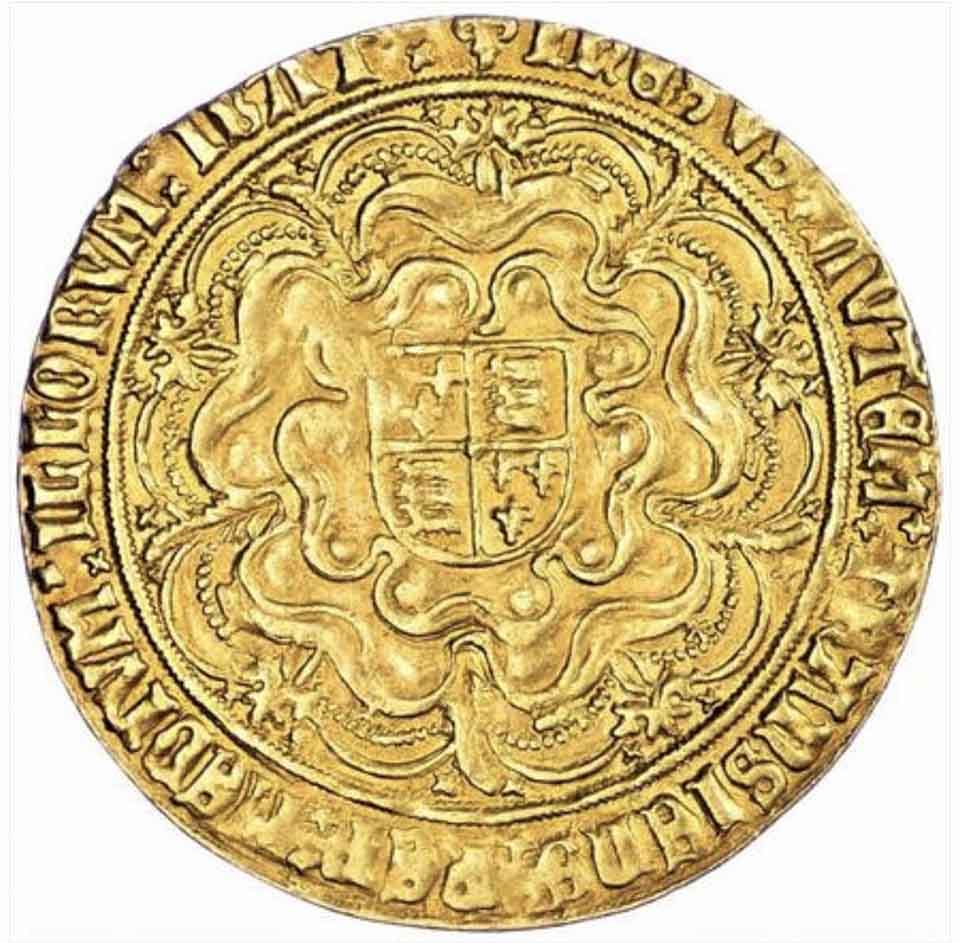
On July 7, Spink, London conducted their Summer Auction of Hammered and Milled Coins. One gold coin stood out from the others, the Henry VIII (1509 -1547), Second Coinage Sovereign. It was described as Very Fine and was in a NGC (Numismatic Grading Cooperation) holder and was graded as AU55 (Almost Uncirculated). The cataloguer described it as very rare with only five traced in modern commerce. The coin in the auction sale could be traced back to a Sotheby sale on 4 April 1927 where it was sold for GBP 18.0.0. In 1950 Glendining sold it for GBP 95.0.0. Spink sold it in 2003 for GBP 13,000. At this latest auction, it was sold for GBP 52,000, including buyer’s premium app. THB 2,808,000. The estimated price was between GBP 40,000-50,000.


Spink China conducted an auction sale in Hong Kong on May 23, 2021, The Numismatic Collectors Series Sale. A uniface obverse and reverse printers model for a HK$5 type of 1911-1922, serial number 0000001 for the Chartered Bank of India, Australia and China was estimated at HK$325,000-HK$450,000. Waterlow & Sons, London, produced the printer’s model. For this interesting and rare printer’s model the buyer had to pay the high estimate of HK$450,000 including the buyer’s premium, app. THB 2,295,000.

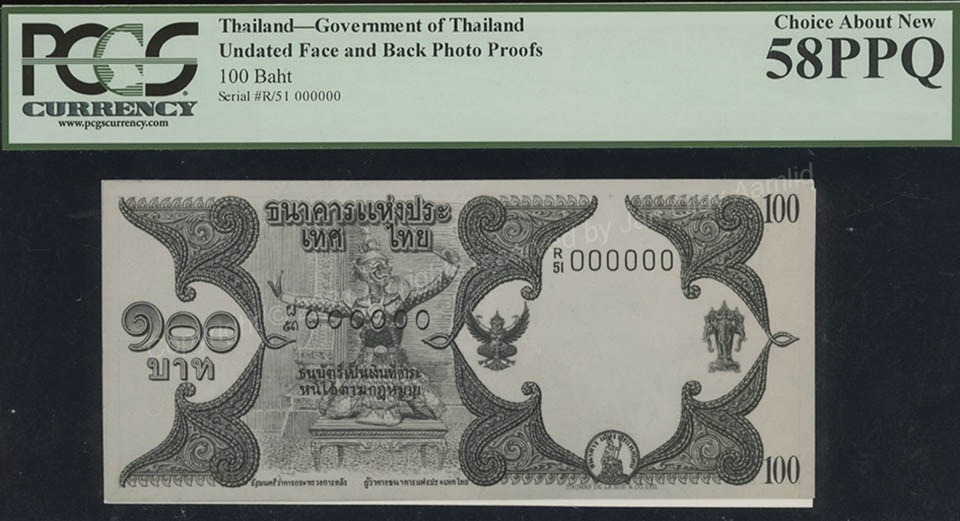

In the Spink China sale there was an interesting obverse and reverse archival photographs of an unissued design of a Thai 100 Baht banknote produced by Thomas de la Rue & Company & Limited London (TdlR) for the Bank of Thailand. The Bank of Thailand was established in 1942 and had plans to issue banknotes in their name.
In the archives of TdlR there was a printer’s model, original artwork, of the obverse of this 100 Baht. But there was no reverse. It was therefore interesting to see the reverse showing an image of the Aisawan Thiphya-Art Pavillion. A four faced open pavilion in the middle of the lake at Bang Pa-in summer palace. It is depicted only on the 20 Baht banknote Fifth Series.
On the reverse of the never issued Bank of Thailand 100 Baht note, a warning is printed on the lower middle part of the banknote in small print. Translated it reads, “The penalty for forging banknotes is 10 years to life in prison and a fine of one thousand baht to ten thousand baht or ten times the value of the forged banknotes whichever the highest amount is.”
This printers model and archival photograph has the serial number R51 000000. This is the same prefix used for one of the One Baht Ninth Series, Type I, which was announced in 1949.
For practical reasons, for the printer’s model and artwork, TdlR often used a number coinciding with the regular printing run because of the signatures of the Minister of Finance and Governor of the Bank of Thailand which were on the 1 Baht banknote. I assume the printer’s model is produced in 1950/51
The obverse and reverse of the archival photographs was estimated to HK$ 8,000 – 12,000 and sold for HK$ 14000, including buyers premium app. THB 71,400.

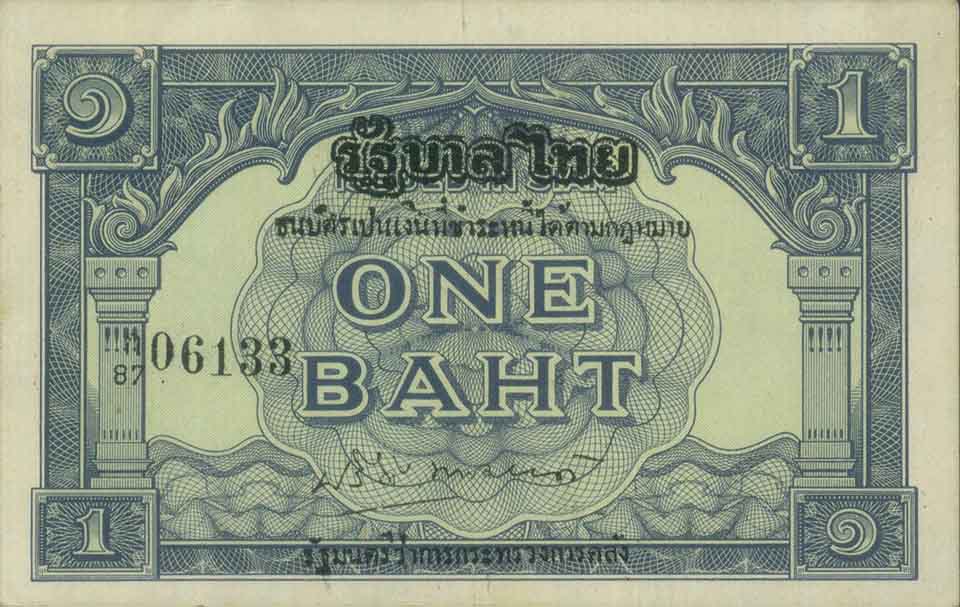

One of the Thai currency notes, which stands out from the other series, is a One Baht banknote announced on June 3, 1946. The note was produced by TdlR and ordered by St Luke’s Printing Works, Bank of England on behalf of the War Office.
During that period the Japanese Imperial Army controlled the economy in Siam, which also included the circulation of banknotes. So, in 1945 the allied Forces set a plan to print seven different denominations, which would look very different to the ones in use. They would then circulate these new banknotes in those areas that they seized back from the Japanese as a symbol of liberation. Only the one Baht was printed.
After the war, the words ISSUED IN SIAM were superimposed with THAI GOVERNMENT and the notes were put into circulation. The other notes, printer’s models and artwork were produced like the 100 Baht banknote as pictured.

During the Covid-19 pandemic, Thailand has designated Phuket as a Sandbox destination and there are plans to setup more Sandboxes at other locations in Thailand.
It might be a good idea to produce special Sandbox currency for use in these designated areas to identify the visitors so they could get special privileges and discounts at hotels, restaurants, shops and recreational activities.
People not vaccinated won’t be eligible to get the Sandbox currency and will not be allowed to enter the Sandbox.
Interestingly the Sandbox Currency could become a valuable collectors’ item in the future.
 |
 |
 |





